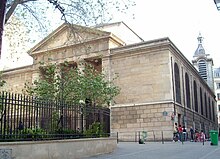Notre-Dame-de-Bonne-Nouvelle (Paris)
The Catholic parish church of Notre-Dame-de-Bonne-Nouvelle was built at the beginning of the 19th century by the architect Étienne-Hippolyte Godde in the classicism style on the site of two previous churches. It is located at 25 rue de la Lune in the 2nd arrondissement of Paris . The nearest metro stations are Bonne Nouvelle and Strasbourg Saint-Denis on lines 8 and 9 . In 1983 the church was added to the list of French architectural monuments as Monument historique .
history
In 1551, a branch church of the parish of Saint-Laurent was built on the site of the current church and initially the patron saints Louis the Holy and St. Dedicated to Barbara (Sainte Barbe). The Church later received the patronage of Notre-Dame-de-Bonne-Nouvelle (Our Lady of the Good News). After this church was destroyed during the Wars of Religion , a new church was built in 1624, for which Anna of Austria laid the foundation stone . In 1673 Notre-Dame-de-Bonne-Nouvelle was elevated to a parish church. From this second church only the bell tower remains. The church was demolished at the beginning of the 19th century as it had suffered severe damage and become dilapidated during the French Revolution .
The present church was built between 1823 and 1830 by Étienne-Hippolyte Godde (1781–1869), the city architect of Paris, who also designed the plans for the Saint-Denys-du-Saint-Sacrement churches in the 3rd arrondissement and Saint-Pierre- du-Gros-Caillou in the 7th arrondissement . Famous painters such as Alexandre-Denis Abel de Pujol (1787–1861) were commissioned to paint the church .
architecture
Exterior construction
The church has a north-south orientation, as the tightly built-up area and the road layout did not allow the usual west-east orientation . In the southeast of the church rises the bell tower of the previous church from the 17th century. The portal facade of the church is designed as a peristyle and is reminiscent of a temple from antiquity. Two Doric columns and two pilasters support an architrave over which a triglyph frieze runs and which is crowned by a triangular gable .
inner space
The church is laid out according to the scheme of an early Christian basilica . The nave has three aisles and is divided into five bays . The central nave is covered with a barrel vault and ends in a semicircular choir , which is spanned by a semi-dome. Arched arcades resting on Doric columns separate the main nave from the two side aisles, which are adjoined by twelve chapels .
Furnishing
- The choir is decorated with a grisaille painting by Abel de Pujol depicting the old people of the Apocalypse who worship God the Father and the Lamb of God . These include paintings from the 16th and 17th centuries in wooden frames such as
- L'Annonciation (The Annunciation), by Giovanni Lanfranco (1582–1647),
- La Bienheureuse Isabelle de France (The blissful Isabella of France presents the model of the Abbey of Longchamp to the Virgin Mary), by Philippe de Champaigne (1602–1674),
- La Vierge entourée de saints (The Virgin Surrounded by Saints), by Ludovico Cardi da Cigoli (1559–1613).
- In the right aisle are the paintings Anne d'Autriche et Henriette de France (Anna of Austria and Henriette of France), which is attributed to Pierre Mignard (1612–1695), and Sainte Geneviève distribuant du pain aux habitants de Paris assiégée (St. . Genoveva distributed bread to the inhabitants of the besieged Paris) by Jean-Victor Schnetz (1787-1870).
- In the left aisle are the paintings L'Assomption (Assumption of the Virgin), attributed to Georges Lallemant (around 1575–1636), and Saint François de Sales, Henriette d'Angleterre et ses trois enfants ( Francis de Sales , Henriette of France and their three Children), attributed to Pierre Mignard.
- The paintings in the Marienkapelle are by Nicolas-Auguste Hesse (1795–1869) and depict scenes from the life of Mary (Annunciation and Visitation) and her parents Anna and Joachim .
- The wooden sculpture of the Madonna and Child comes from the 18th century.
- The sculpture of St. Jerome made of alabaster is dated to the early 17th century.
organ
The organ is the work of the organ builder John Albert Abbey . It was installed at the end of the 19th century and restored in 1950 by Joseph Gutschenritter (1950) and Jean-Marc Cicchero (1988). The instrument has 19 stops on two manuals and a pedal . The playing and stop actions are mechanical, the action of the pedal is pneumatic.
|
|
|
||||||||||||||||||||||||||||||||||||||||||||||||||||||||||||||||||||||
- Coupling : II / I, I / P, II / P
literature
- Georges Brunel, Marie-Laure Deschamps-Bourgeon, Yves Gagneux: Dictionnaire des Églises de Paris . Éditions Hervas, Paris 2000 (1st edition 1995), ISBN 2-903118-77-9 , pp. 154-156.
- Jean Colson, Marie-Christine Lauroa (eds.): Dictionnaire des Monuments de Paris , Paris 2003 (1st edition 1992), ISBN 2-84334-001-2 , p. 538.
- Aline Dumoulin, Alexandra Ardisson, Jérôme Maingard, Murielle Antonello: Paris D'Église en Église . Éditions Massin, Paris 2008, ISBN 978-2-7072-0583-4 , pp. 44-47.
- Werner Szambien: L'église de ND-de-Bonne-Nouvelle . In: Le Sentier. Bonne Nouvelle . Collection Paris et son Patrimoine, published by Action Artistique de la Ville de Paris, Paris 1999, ISBN 2-913246-01-X .
Web links
- Église Notre-Dame-de-Bonne-Nouvelle in the Base Mérimée of the French Ministry of Culture (French)
Individual evidence
Coordinates: 48 ° 52 ′ 10.5 " N , 2 ° 20 ′ 59.5" E

